(1979,US)

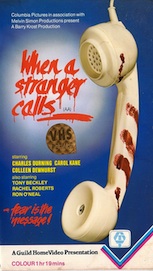

[review by JA Kerswell]
Fred Walton's WHEN A STRANGER CALLS manages to be both loosely a classic of the subgenre and an inversion of it at the same time. Audiences keen for more thrills akin to the previous year's HALLOWEEN (1978) must have been delighted by the film's opening and closing bookends, but thoroughly bewildered by its midsection. First time watchers today are even more likely to find its stop-start nature jarring, but that's not to say there isn't much to enjoy.
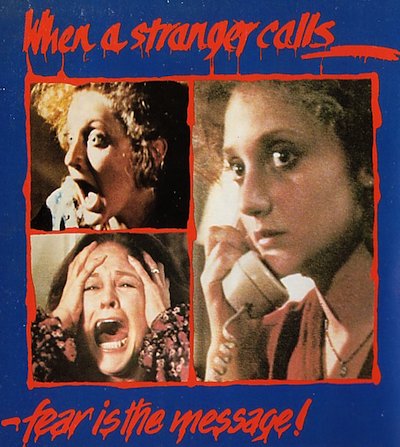 |
|
| Detail
from back of British VHS for WHEN A
STRANGER CALLS |
Full disclosure: I'm sure I'm not the only wag who phoned a friend after a late night screening of WHEN A STRANGER CALLS and - after an ominous pause - asked them in a raspy voice: "Have you checked the children?". The first 20 minutes of the film is a masterclass in suspense. A young student named Jill (Carol Kane) arrives to babysit for Dr Mandrakis and his wife (Rutanya Alda). They tell her not to wake the children as they are fast asleep, but Jill soon begins receiving phone calls asking her if she has looked in on her charges. The calls become more insistent and disturbing; enough so that Jill begs for help from the police. Eventually they trace the call and tell her to flee the house - as the calls are coming from upstairs ...
This scene is skilfully put together to evoke escalating terror. Like John Carpenter's HALLOWEEN, Ward uses wide shots to hint at places where the killer may lurk in darkness and to emphasise how utterly alone Jill is. Although she (and the audience through clever misdirection) believes the threat of the phantom caller lurks without, he actually lurks within. As opening scenes go it is legendary, and the film's reputation as one of the scariest films of the time hinges on it. It is legendary in other ways, too, as it is in part based an urban legend that can be traced back to at least the 1960s.
Whilst these first 20 minutes make for a throat-grabbing opening Walton decided not to stretch it to feature length when he made WHEN A STRANGER CALLS (unlike the 2006 remake). This left him with a conundrum of how to expand the story. The route he chose was controversial and one that turned audience expectations on their heads, when the film all but jettisons popcorn boo chills for a downbeat character study and manhunt.
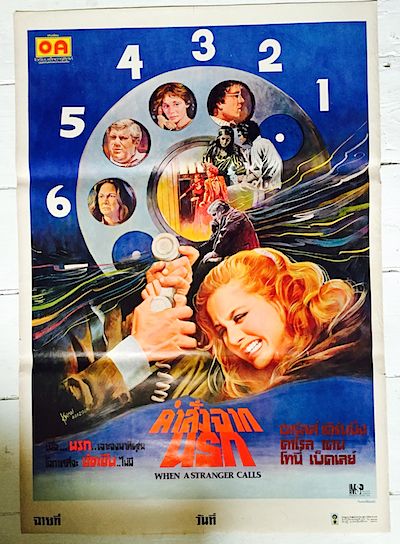 |
|
| My
copy of the beautiful Thai cinema poster for WHEN A
STRANGER CALLS |
The killer, Curt Duncan, is played by the late actor Tony Beckley (who was dying of cancer whilst he was making the film; something which imbues his performance with a sense of sadness, pathos and strange inevitability). The portrayal of the killer is as schizophrenic as the movie. During the film's tense opening scene we never see him, only hear his voice and see his shadow on the wall. We later find out that he dismembered the children with his bare hands. Flash forward seven years and he has escaped the asylum. So far so Michael Myers. However, Duncan is no faceless boogeyman. Rather he is played as a pathetic (in the truest sense of the word), weedy individual whose bid for freedom and normality unravels in the most human and mundanely degrading ways possible. His desperation, meltdowns and subsequent destitution appear to have been the blueprint for the killer in Romano Scavolini's NIGHTMARES IN A DAMAGED BRAIN (1981) - which took the inherent sleaziness of this film and amped it up to twelve.
Hot on Duncan's trail is John Clifford (Charles Durning). As the film's rather portly Dr Loomis character, he was the cop that saved Jill and now seven years later is a PI hired by the Mandrakis family to bring Duncan back into custody. However, Clifford confesses to a former colleague that he simply wants to find him and kill him. This gives the film an off-kilter moral ambiguity - so much so that Durning reputedly asked Walton if he was the actual villain. Duncan and Clifford embark on a game of cat and mouse as he is tracked to the apartment of a world-weary woman who feels sorry for him (Colleen Dewhurst), and then across skid row and various flop houses. However, before he can stop him Duncan tracks down Jill once again and begins to menace her new family in scenes that recall those of the first 20 minutes to a lesser degree of success, but still manage to jar and frighten as Duncan once again becomes the inscrutable and deranged madman intent on playing deadly games.
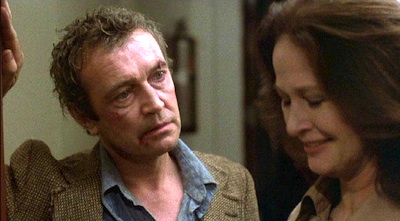 |
|
| Tony
Beckley plays the atypical killer in Fed Walton's WHEN A
STRANGER CALLS |
Walton had made his short film THE SITTER in 1977 - and the first 20 minutes of WHEN A STRANGER CALLS is almost a shot-for-shot remake. In the short, Jill was played by an actress that conformed to the ideal of the All American blonde. Walton wanted a similar actress for the feature, but ended up with Carol Kane because of her relationship with ****. Walton was initially concerned because of Kane's inherent quirkiness, which he feared would tell the audience that something is 'off' before the first phantom phone all. However, it is difficult to imagine anyone else in that role now - and Kane is sympathetic and believable in dual roles as both the boy obsessed teen and later the young mother.
Although considered a classic now - and certainly a forerunner of the modern slasher movie - Bob Clark's BLACK CHRISTMAS (1974) failed to make much of an impact at the box office on both its initial releases. Therefore Walton may have felt that enough of the audience would find the adaptation of the urban legend of the calls coming from within the house a fresh and frightening concept. The film was made independently (by Simon Film Productions) and was picked up and released to North American screens by Columbia just before Halloween 1979. By this point Carpenter's HALLOWEEN had already become a full blown sleeper hit. However, perhaps surprisingly, Ward's film was not directly inspired by HALLOWEEN as it began shooting in October 1978 - the same month as Carpenter's film was unleashed on its slow build to a commercial crescendo. As with SILENT SCREAM (also 1979), WHEN A STRANGER CALLS was one of the first films to fill the surprising immediate void that followed Carpenters' breakout hit. Like SILENT SCREAM, in a case of exceptional timing, the film resonated with a horror hungry audience and quickly racked up box office in excess of $20 million despite mixed reviews.
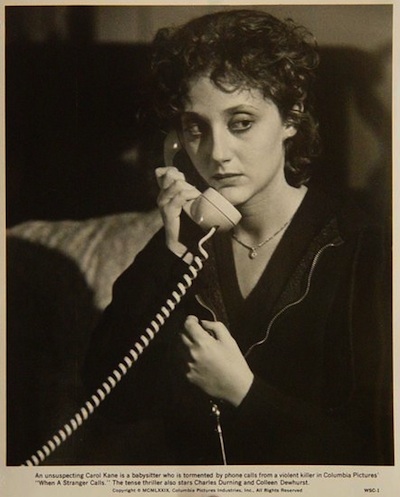 |
|
| Publicity
of Carol Kane as the menaced babysitter in WHEN A
STRANGER CALLS |
The film's poster trumpeted a quote from After Dark magazine that screamed: "Unequivocally the most terrifying film I have ever seen." However Roger Ebert dismissed the film as "sleazy", whilst Variety was more positive: "[it] ... works up a basketful of scary passages under writer Fred Walton's cunning direction." Time magazine called it "[a] ... wretchedly inept creaking-door flick". Janet Maslin, in The New York Times, complained that the film had good actors that were "miscast". However, she did acknowledge Walton's skills to scare. She said: "The frightened-babysitter opening of the movie is marvellously modern, as Mr. Walton demonstrates that a haunted house with an ice-making refrigerator is intrinsically scarier than a house without one. He also makes the most of that fearsome modern weapon, the telephone." Dann Gire - a critic who usually hated slasher movies with a passion - gave it a more positive review in his September 26, 1979 review in The Daily Herald. He said, "When a Stranger Calls is an effective "bogeyman" piece because it preys upon our innermost fears. The violation of home security plays a role in the scare tactics. If you can't feel safe in your own home, where can you feel safe?". Interestingly, he said the film was more powerful because it was based on a 'true' account: "The basic story [...] was taken from a 1972 Santa Monica newspaper account of a baby-sitter who was being tormented by a mysterious phone caller. Police later discovered the caller was in the house at the time."
The profit the film generated, compared to relatively small outlay, helped drive the interest in the majors to pick up independent slasher flicks - which really hit pay dirt in 1980 with Paramount's release of Sean Cunningham's FRIDAY THE 13TH. Columbia returned to the subgenre with lesser - although not inconsequential - financial success with HAPPY BIRTHDAY TO ME in 1981.
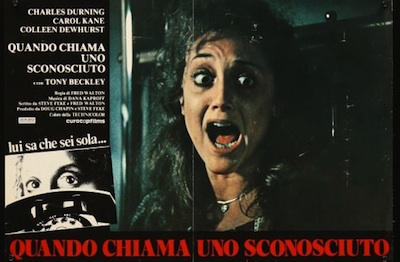 |
|
| Italian photobusta for WHEN A
STRANGER CALLS |
It is therefore ironic then that whilst WHEN A STRANGER CALLS not only played a large role in propelling the slasher movie into the mainstream arena and prompted interest from the majors - and the fact that it was inspired by one of the most seminal subgenre movies ever made - that it isn't really a slasher movie as such (although it shares enough tropes and themes to be included here). By that point the formula had not been set, and Walton used his short to produce a film that subverts the emerging conventions by accidentally refusing to adhere to them. Arguably, WHEN A STRANGER CALLS would have been a more satisfying film had it concentrated on Jill's character and the threat from Duncan throughout rather than relegate her to parts that bookend the movie. If he had seen HALLOWEEN before making the film that might have almost certainly been the case. However, the more realistic and downbeat central section still remains interesting.
The film was reissued by Columbia in October 1980 and was still in intermittent release throughout 1981 (in at least one instance playing on a double bill with THE BURNING (1981) and on another with stablemate HAPPY BIRTHDAY TO ME). The film was given a AA certificate by the BBFC for its UK cinema release by Barber Dann Films Ltd in June 1979.
The film did its own amount of influencing when its famous opening
scenes provided the inspiration for the opening of Kevin Williamson and
Wes Craven's SCREAM (1996).
Kane and Durning were reunited for the surprising good sequel
made-for-TV WHEN A STRANGER CALLS
BACK AGAIN (1993). A second sequel was promised but never
appeared (although it was still in development as late as 2011) and
eventually the remake appeared in 2006. Walton embraced the slasher
movie legacy with his playful semi spoof APRIL FOOL'S DAY (1986), as well as
the Kathleen Quinlan TV suspenser TRAPPED
(1989). Kane went into make slasher spoof PANDEMONIUM (1982) and OFFICE KILLER (1997). Whilst Durning
also made a memorable appearance in TV slasher DARK NIGHT OF THE SCARECROW (1981).
BODYCOUNT 3
 female:1 / male:2
female:1 / male:2
1) Female dismembered
(off-screen)
2) Male dismembered
(off-screen)
3) Male shot several
times